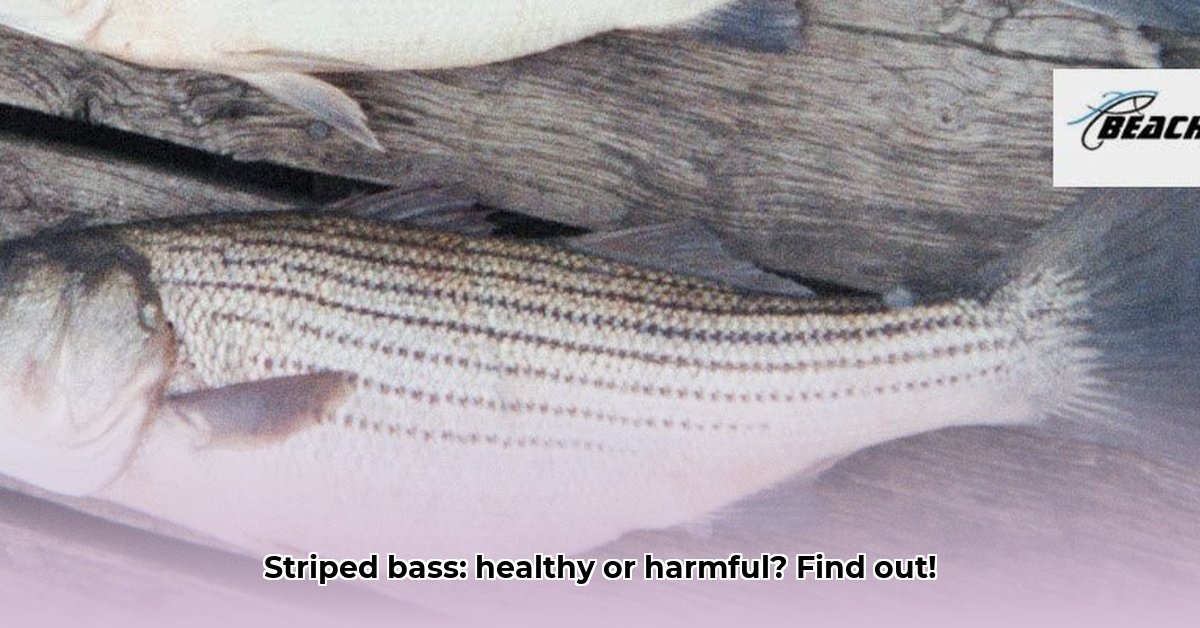Love striped bass? Who doesn’t! It’s firm, it’s flavorful, and it’s a popular choice for dinner. But before you dig in, let’s talk about something important: is it actually safe to eat? This guide cuts through the confusing stuff about mercury, chemicals, and where your fish comes from, and gives you the straight facts. We’ll cover how to cook it safely, how to make sure you’re getting it from a sustainable source, and why picking smaller fish makes a big difference. By the end, you’ll know exactly how to enjoy delicious striped bass while keeping yourself healthy. For similar concerns about other fish, check out this helpful guide on trout safety: trout safety.
Is Striped Bass Consumption Safe? Evaluating the Health Benefits and Concerns
Let’s talk about striped bass – a delicious fish many of us enjoy. But is it always a healthy choice? The answer, like many things in life, isn’t a simple yes or no. It’s a bit more complicated than that. Think of it as a delicious balancing act between tasty benefits and potential downsides, understanding both the nutritional value and potential contaminants.
Unveiling the Nutritional Benefits and Potential Risks: Is It Safe To Eat Striped Bass?
Striped bass is packed with good stuff! We’re talking protein, which builds and repairs our bodies, and omega-3 fatty acids, those superstars for heart and brain health. It’s also a good source of various vitamins and minerals, including vitamin D, selenium, and B vitamins. It’s a nutritional powerhouse, essentially offering both macro and micronutrients. However, there’s a catch. Like many fish, striped bass can accumulate mercury and PCBs (polychlorinated biphenyls) from the environment. These are toxins that can build up in a fish’s body over its lifetime and pose health concerns. The accumulation is tied to the fish size, meaning the bigger the fish, and therefore, the older it is, the higher the concentration of these toxins tends to be. Mercury levels in striped bass typically range from 0.016 to 0.727 parts per million (ppm), but this can vary.
Evaluating Risks: Who Should Limit or Avoid Striped Bass?
The risk from mercury and PCBs (persistent organic pollutants) is especially high for certain groups. Pregnant women and new moms who are breastfeeding need to be extra cautious. Why? Because mercury can seriously impact a baby’s developing brain and nervous system. Young children are also particularly vulnerable for the same reason, since their neurological development is still sensitive. The EPA recommends that pregnant women, breastfeeding mothers, and children limit their consumption of fish with high mercury to protect against developmental issues. For these groups, limiting or avoiding striped bass entirely is probably the best course of action. It’s better to be safe than sorry when it comes to a developing child’s health, protecting them from potential developmental issues.
Moderate Consumption for Healthy Adults: Balancing Enjoyment and Safety
For healthy adults, enjoying striped bass in moderation is generally considered okay. But what exactly does “moderate” mean? Experts typically suggest limiting yourself to one to two servings per week, maximum. Even then, choosing smaller striped bass is a smart move, minimizing health risks. Why? Smaller fish simply haven’t had as much time to accumulate those environmental toxins we talked about earlier, ensuring safer levels of contamination. Think of it like this: the smaller the fish, the less time it had to absorb these things from its surroundings.
Guide to Safe Striped Bass Consumption: Smart Choices for Minimizing Risks
Here’s how to make smart choices and minimize any potential risks associated with striped bass consumption:
-
Go Small: Opt for smaller striped bass whenever possible. They tend to have significantly lower levels of mercury and PCBs (polychlorinated biphenyls). Smaller fish typically have reduced toxin accumulation. A good size to aim for is between 18 and 30 inches.
-
Check Local Advisories: Your local health department or environmental agency likely publishes fish consumption advisories specific to your region. These advisories offer guidance tailored to your area’s water conditions and the fish caught there. Check these regularly. They’re a valuable resource for safe eating guidelines.
-
Clean Thoroughly: Before cooking, give your striped bass a good, thorough cleaning. This helps remove any surface contaminants that might be present, improving overall safety. Remove the skin and trim any visible fat, as PCBs tend to accumulate in fatty tissues.
-
Cooking Methods Matter: Baking, grilling, or steaming are healthier choices than frying. Frying adds extra fat and calories, which aren’t ideal for a balanced diet.
Here’s a handy table summarizing the consumption recommendations:
| Group | Recommendation |
|---|---|
| Pregnant/Nursing Women | Limit or avoid |
| Children (<18 years old) | Limit or avoid |
| Healthy Adults | Up to 1-2 servings per week; choose smaller fish |
The Verdict: Information and Moderation are Key to Eating Fish Safely
So, is striped bass healthy to eat? The answer isn’t black and white. It depends on several things, such as who’s eating it, how often, and the size of the fish. While striped bass offers some fantastic nutritional benefits, the presence of mercury and PCBs requires careful consideration. By making informed decisions about the size of fish you buy, how often you eat it, and how you prepare it, you can enjoy this delicious fish while minimizing potential health risks. Remember, moderation and awareness are key to ensuring fish safety and nutritional advantages. And remember, research in this area is ongoing, so guidelines might change over time. Check for updates from your local health authorities and organizations like the EPA and FDA.
How to Reduce Mercury Exposure from Striped Bass: A Practical Guide
Key Takeaways:
- Striped bass are a nutritious food, but mercury levels vary, emphasizing the need for smart purchasing and preparation.
- Smaller fish generally have lower mercury, making size a crucial factor when selecting your fish.
- Proper cleaning and cooking methods are crucial for overall food safety, complementing the selection of smaller fish.
- Following recommended serving sizes minimizes risk, balancing nutritional benefits and mercury exposure.
- Sustainable fishing practices support healthy populations, ensuring the long-term availability of this resource.
Understanding Mercury Accumulation in Striped Bass: Factors to Consider
Striped bass, a popular game fish, offer delicious flavor and valuable nutrients. However, like many predatory fish, they can accumulate mercury from their environment, raising health concerns. So, how do we enjoy this tasty fish while minimizing our mercury intake? The answer lies in a combination of smart choices and careful preparation.
The amount of mercury in striped bass varies depending on several factors. Larger, older fish tend to concentrate more mercury in their tissues, creating a greater risk. Where the fish was caught also matters; waters near industrial areas may have higher mercury levels. Coastal waters near urban or industrial areas are more likely to have elevated mercury levels. This means that how to reduce mercury levels in striped bass before cooking isn’t about removing mercury once it’s in the flesh, but rather choosing fish with lower concentrations to begin with. To reduce mercury levels, it’s important to target the root cause of the problem.
Striped Bass Sizing: Choosing Your Striped Bass Wisely to Limit Mercury Content
The best way to minimize your mercury intake is to select smaller striped bass. Aim for fish between 18 and 30 inches long. These younger fish generally have lower mercury concentrations compared to their larger counterparts. Avoid fish larger than 30 inches, as their mercury levels increase significantly, posing a higher risk. Check local fishing advisories or contact your health department for region-specific recommendations, ensuring up-to-date information. This is an important first step in answering how to reduce mercury levels in striped bass before cooking, prioritizing safer fish choices.
Safe Food Preparation: Cooking for Safety and Flavor with Minimal Risk
Once you’ve chosen your striped bass, proper cleaning and preparation play a role in enhancing not only the taste but also minimizing any potential risks. Always thoroughly clean and gut your fish, removing potential contaminants. Removing the skin and any visible fat can also help reduce mercury exposure slightly, although the largest impact comes from selecting smaller fish.
While cooking doesn’t remove mercury from the fish itself, proper cooking methods are important for overall food safety. Make sure your striped bass is cooked to an internal temperature of 145°F (63°C) to kill any harmful bacteria or parasites, ensuring safe consumption. There are numerous delicious and healthy ways to prepare striped bass – grilling, baking, pan-frying – the possibilities are endless, offering diverse culinary experiences.
Servings and Frequency: Consumption Guidelines for a Balanced Approach
Even with careful selection and preparation, moderation is key when it comes to consuming fish. Health agencies often recommend limiting consumption of larger predatory fish like striped bass due to potential mercury exposure, ensuring responsible eating habits. Following recommended serving sizes is vital, balancing the health benefits with potential risks.
| Serving Size | Frequency |
|---|---|
| 4 ounces (approx. 113g) | 1-2 servings per month (for larger fish) |
| 4 ounces (approx. 113g) | Up to 2 servings per week (for smaller fish) |
Remember, the goal is to enjoy the benefits of striped bass without unnecessary risk, promoting responsible dietary choices.
Understanding Coastal Striped Bass Mercury Levels: Rewards vs. Risks
Key Takeaways:
- Bento Box Glass Offers Practical, Eco-Friendly Meal Storage - December 16, 2025
- The Best Bento Box Price For Your Perfect Packed Lunch - December 15, 2025
- Bento Box Shopping Tips for Smart and Stylish Lunch Prep - December 14, 2025










